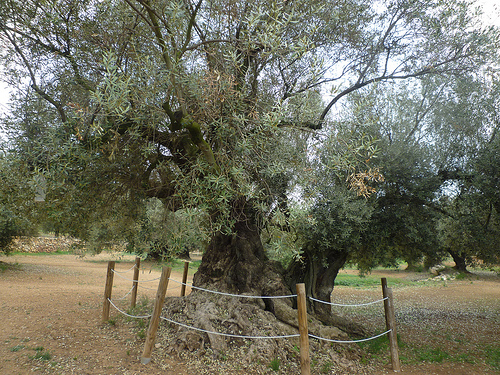Has been completed the first phase of reading of the DNA olive, an ancient tree. This reading could help improve olive production.
A project led by the Higher Council for Scientific Research (CSIC) has initiated a study, that is expected to last for three years, that seeks to find genetic clues that could help the olive tree to improve olive production. Currently, the research team has achieved a first complete DNA sequencing of this tree.
The study, funded by Santander Bank, is being carried out on the sequencers of the National Centre for Genomic Analysis and the computers of the Centre for Genomic Regulation.
The project is led by the researcher of the CSIC, Pablo Vargas, of the Royal Botanic Gardens, where it has been carried out the DNA extraction of the individual studied. It is an olive tree variety "Farga" (“Forge”), aged scientifically estimated between 1,100 and 1,300 years old, originating from the Sierra del Maestrazgo (Castellón, Esatern Spain), reported by the CSIC in a note.

La Farga, olivera bi-mil-lenaria, by Matilde Martínez, at flickr.com
In 2005, it was transplanted into the gardens of the Banco Santander Financial City in Boadilla del Monte (Madrid), which is alive and growing. The olive tree, called Santander, weighs about 11 tons and has a perimeter of about five meters. The Forge variety has been chosen to be the type of olive tree with the most ancient individual in Spain.
"Reading DNA olive is a milestone in the field of genetic sequencing, because it is a kind of extraordinary longevity. All the organisms sequenced so far are living a few years, depending on the life expectancy of each species. However, this is the first time you do with a subject that has existed over a thousand years and probably get to live many more ", explains Vargas.
The data collected so far, corresponding to the raw sequencing, have been included this week in the European repository nucleotides (European Nucleotide Archive).
The results of this work will allow in-depth knowledge of a plant that is part of life and the power of human beings from about 8,000 years ago, when it began a process of domestication of wild olive, from which current olive emerged.
"DNA sequencing of the olive tree will reveal the genetic basis of that domestication process; it will give the keys of local adaptations that have enabled the species to survive and allow us to confirm its origins. All this information will help in future genetic improvement of olive production, of great importance in the Spanish economy”, Vargas concludes.
This study seems to be very interesting ; is not it?.
Till soon, kind regards,
Luis.
Sponsored by Costaluz Lawyers.
Please click down here:
